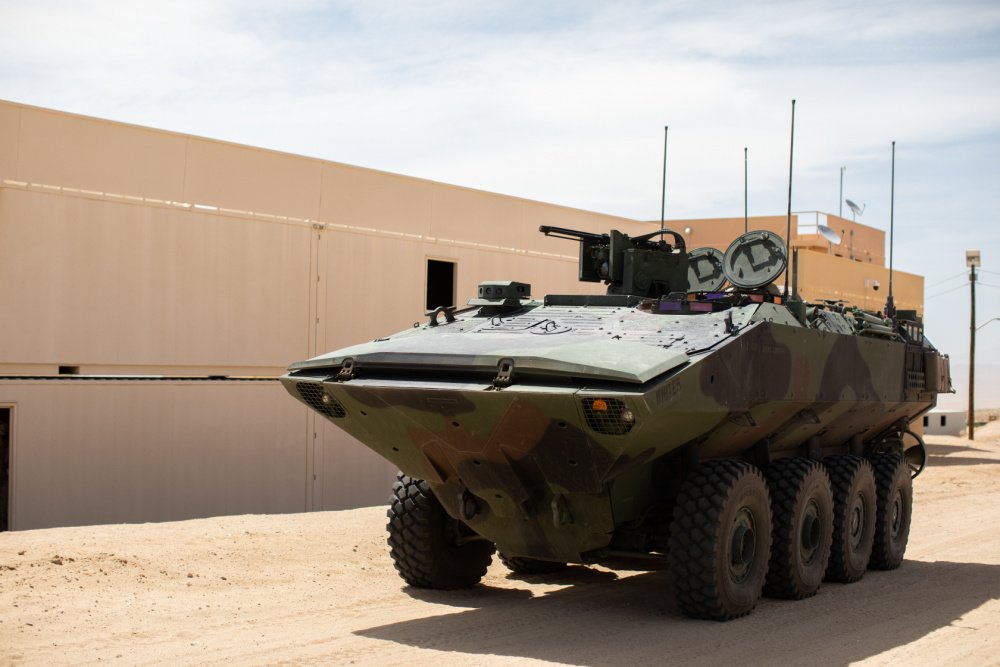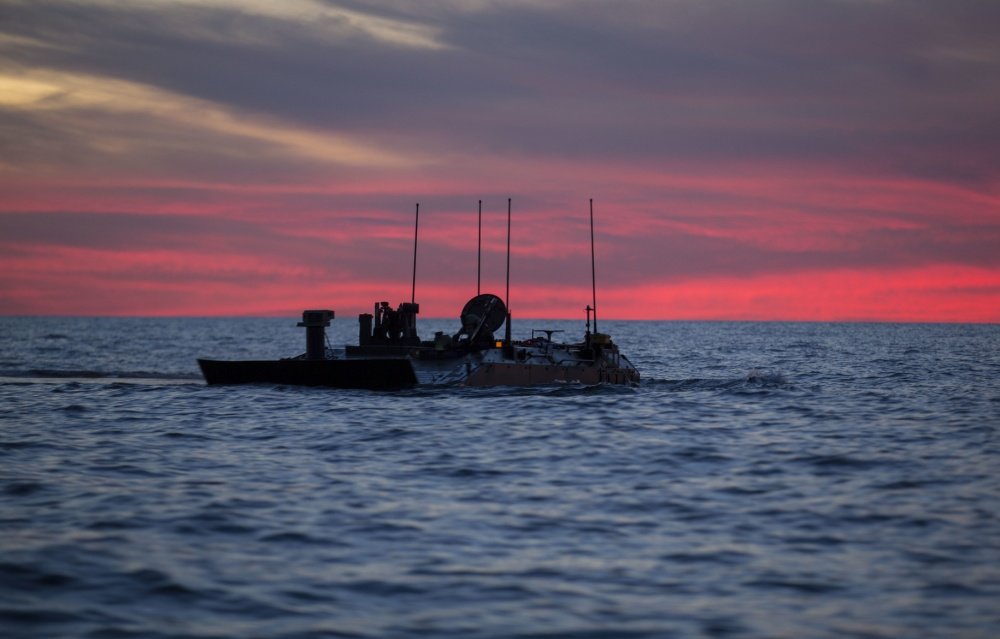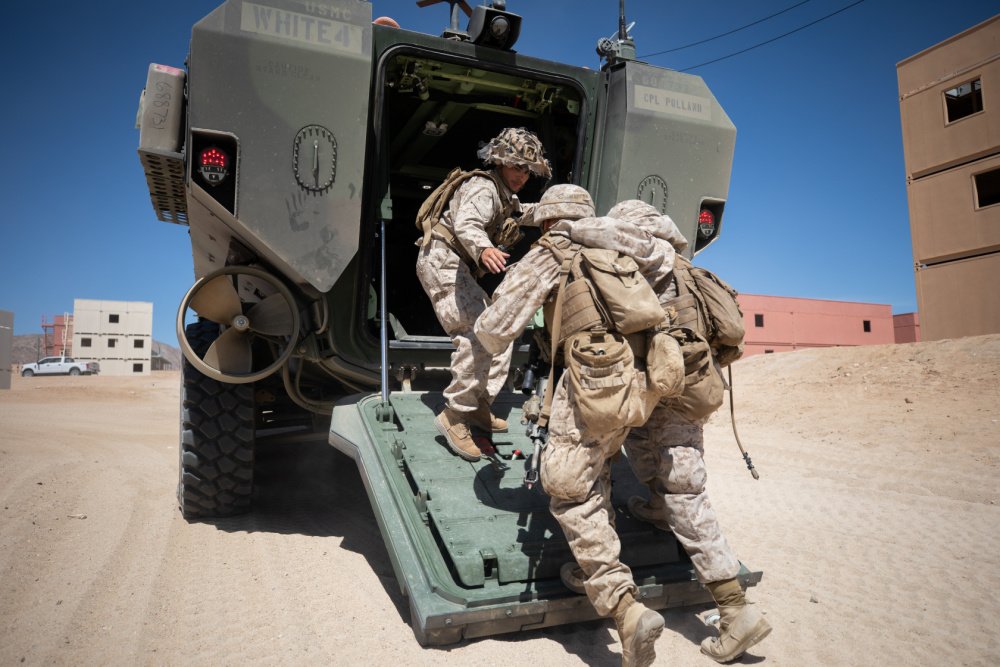Marine Corps Wants 92 Amphibious Combat Vehicles To Replace Aging AAV Fleet

Marines with Amphibious Vehicle Test Branch, Marine Corps Tactical Systems Support Activity, drive a new Amphibious Combat Vehicle ashore during low-light surf transit testing at AVTB Beach on Marine Corps Base Camp Pendleton, Calif. US Marine Corps photo by Lance Cpl. Andrew Cortez, courtesy of DVIDS.
As the Marine Corps continues to modernize under Commandant of the Marine Corps Gen. David Berger’s “Force Design 2030” plan, the branch requested 92 Amphibious Combat Vehicles (ACVs) in the Department of Defense Fiscal Year 2022 Budget Request, up from 72 the previous year. The move signaled that the service is moving full speed ahead toward replacing the Assault Amphibious Vehicles, or AAVs, which the Marine Corps has employed since 1972.
With some planned variants featuring remote-operated 30 mm cannons, the ability to reach 65 miles per hour on land, increased blast protection for the Marines inside, and open-system architecture, the new ACV appears to be a lethal and worthy upgrade to the venerable Vietnam-era AAV.

Weapons mounted on ACVs are remotely operated and highly accurate. According to a Pentagon report, the primary weapon system for the ACV is a “single mount Remote Weapons System,” which is equipped with either an Mk-19 40 mm automatic grenade launcher or the M2 .50-caliber heavy machine gun.
According to a Pentagon report, “The [Remote Weapons System] offers several advantages over the legacy AAV Up-gunned Weapons Station, to include a dedicated gunner, weapons and sight stabilization, a laser range finder, and a modern fire control system.”
During gunnery tests, ACV sections hit 91% of targets when stationary and 97% of targets while on the move.
Built with an “open architecture” design, crews can easily swap weapons platforms on ACVs to meet various mission sets. According to the US Naval Institute, the Marine Corps currently plans to field 175 ACVs featuring remotely operated 30 mm cannons to provide additional firepower during operations.

John Swift, BAE Systems’ amphibious vehicles program director, told the USNI that swapping the cannon for rocket or missile launchers was both a “feasible and supportable” option for the vehicle. That capability could be key as the Marine Corps moves toward fully implementing the “littoral concept.” The Marine Corps asked for dozens of anti-ship missiles in this year’s budget request, and this capability will likely be a feature of the service moving forward.
In its overall design, the ACV features some major differences from the AAV. The ACV runs on eight wheels instead of on tracks, similar to the Stryker or Marine Corps Light Armored Vehicle. Additionally, the troop compartment in the ACV is designed to hold 13 Marines rather than the 21 troops the AAV is designed to hold; the ACV’s primary focus is on protecting the Marines inside from weapons blasts.

Adjustments to the troop compartment resulted from lessons learned in Iraq and Afghanistan, where the unarmored bottoms of AAVs left the Marines inside vulnerable to improvised explosive devices (IEDs). A stark reminder of this vulnerability occurred on Aug. 3, 2005, when 14 Marines were killed outside of Haditha, Iraq, after an IED detonated under the unarmored belly of the vehicle.
To mitigate blasts, the ACV features extra armor as well as a “V-shaped” hull designed to deflect energy generated by an explosion out from under the vehicle. Each Marine sits in a specialized seat designed to mitigate the impact of an explosion. In AAVs, Marines sit on benches. The results of these design adjustments, according to BAE, are “a force protection capability three times greater than the AAV.”
Another major upgrade with the ACV is its state-of-the-art electronics and communications suite. Designed to include the satellite-based Joint Battle Command Platform, the upgrade enables the vehicle to rely on more than traditional radio communications on the battlefield. Failing radios were a key component of the July 2020 AAV accident off California, which claimed the lives of eight Marines and a sailor. After the radios on the doomed AAV failed, the vehicle commander was relegated to waving a distress flag for nearly 20 minutes.

The state-of-the-art ACV communications suite also features built-in cybersecurity measures. Although the specific details are classified, a Navy report states: “ACV operators demonstrated the ability to defend and recover against some insider and nearsider cyberattacks.”
With increased firepower, survivability, and a modern electronics suite, the ACV represents a modern solution to the venerable AAV while also providing an adaptable platform for future fights.
“The ACV was designed to meet the Marines’ needs of today while allowing for growth to meet future mission role requirements,” Swift said in a statement.
Read Next: III Marine Expeditionary Force AAVs Return to Water

James Webb served as a US Marine infantryman from 2005 to 2010, completing a combat tour in Iraq. He’s worked as a freelance writer and photojournalist covering US troops in Afghanistan, and Webb spent more than two years in the US Senate as a military legislative assistant and as the personal representative of a member on the US Senate Foreign Relations Committee.
BRCC and Bad Moon Print Press team up for an exclusive, limited-edition T-shirt design!
BRCC partners with Team Room Design for an exclusive T-shirt release!
Thirty Seconds Out has partnered with BRCC for an exclusive shirt design invoking the God of Winter.
Lucas O'Hara of Grizzly Forge has teamed up with BRCC for a badass, exclusive Shirt Club T-shirt design featuring his most popular knife and tiomahawk.
Coffee or Die sits down with one of the graphic designers behind Black Rifle Coffee's signature look and vibe.
Biden will award the Medal of Honor to a Vietnam War Army helicopter pilot who risked his life to save a reconnaissance team from almost certain death.
Ever wonder how much Jack Mandaville would f*ck sh*t up if he went back in time? The American Revolution didn't even see him coming.
A nearly 200-year-old West Point time capsule that at first appeared to yield little more than dust contains hidden treasure, the US Military Academy said.












